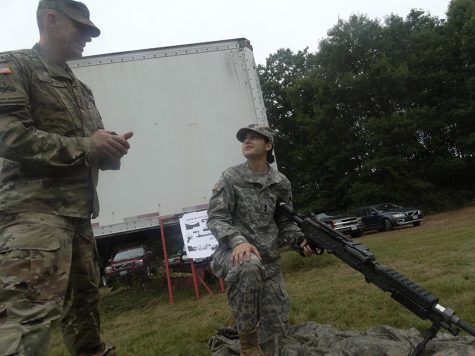Maps and machine guns: UMass ROTC is back in action
September 21, 2017
Maps and Machine Guns: A UMass Amherst Minuteman Battalion Army ROTC field training exercise from Morgan Hughes on Vimeo.
MONTAGUE — Cadets from the University of Massachusetts Amherst Minuteman Battalion headed for Montague to conduct their first training of the year on Saturday.
For the older cadets, this was another routine lab, a chance to practice known skills. But for the freshmen, this would be their first taste of ROTC life.
The air was a thick hot soup, spitting in the face of normal September weather conditions. Carpools of camouflaged drivers came and went, picking up their passengers in personal vehicles.
Cadet Sami Auriemma, an MS3, or a third-year cadet, had a full car. In her vehicle were two silent freshmen and two more experienced cadets. One of the passengers, another MS3, Kelsey DeWolfe, commented that last night would have been a good night to sleep outside.
“No night is a good night to sleep in the field,” Auriemma said.
Dozens of cadets arrived at the exercise, and were split into groups shortly after. One group began with land navigation, the other with weapon systems.
There were three firearms to learn from: the M249 Squad Automatic Weapon, or SAW, light machine gun, the M240 Bravo machine gun and the M16 rifle. Each weapon had an hour-long station where cadets would practice disassembling and reassembling each weapon under the guidance of an experienced cadre member or MS4.

Sgt. Eric Oberndorf oversaw the M249s, light machine guns that fire belts of 5.56 mm ammunition. Each one weighs about 22 pounds fully loaded, and like all the other guns at the exercise, can be disassembled by hand.
Oberndorf broke down the weapon piece by piece, walking the cadets through the process. Afterwards, it was their turn to practice disassembling one of the three SAW’s themselves.
Older students were able to strip the guns with relative ease, while fresh recruits struggled the first few times. The weapon can break down into over a dozen parts — a daunting prospect for first-timers. Although he came off gruff in his humor, the sergeant was patient with his students.
“Don’t be afraid to ask [questions], now is the time to learn,” he said as cadets snapped together steel components.
The next station was the M16, a classic military rifle that also fires 5.56 mm rounds. Unlike the M249, the M16 is much smaller and takes only magazines of ammunition. Cadets at this station were much more familiar with this weapon, and held little timed competitions to see who could break down and reassemble the rifle fastest.
Master Sgt. John Diggles demonstrated how to break down the M240, best described as a bigger version of the M249, weighing almost 28 pounds. The weapon is also belt-fed but fires thicker 7.62 mm bullets, a caliber known for dealing heavy damage.
“This thing looks more intimidating than it is,” Diggles said with a smirk. “Unless you’re on the receiving end.”

The second half of the day was spent in an outdoor classroom where MS4s reviewed the principles of land navigation with their less experienced peers. After the lesson, cadets were assigned points to locate using compasses, protractors and maps.
The land navigation did not go as smoothly as weapons training. The usually calm forest was not known to be home to ground wasps, and although the battalion knew of this new risk, a few unlucky cadets got stung.
After the land navigation, the battalion returned to the staging area for a debriefing of the day and a swearing-in ceremony. Cadets Adam Donaruma, Eric Anderson, Jacob Cohen, Robert Watkinson, Yaziel Rivera and Jonathan Laverdiere took their oaths of service to the United States Military in front of the battalion.
After this ceremony, Lt. Col. Stephen Magner addressed the battalion and congratulated the recent contractees. He reminded them of the sacrifice that enlisted personnel make.
“Some of you got stung by bees, but out there some guys get stung by IED’s (improvised explosive devices), and we can’t forget their sacrifice,” Magner said.
Email Jon at [email protected] or follow him on Twitter @Jon_H_Decker.
